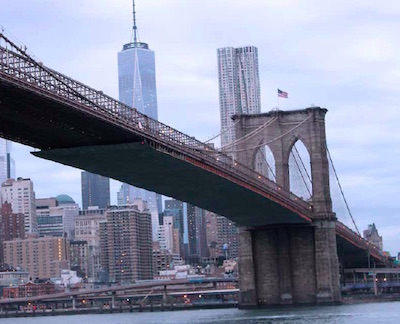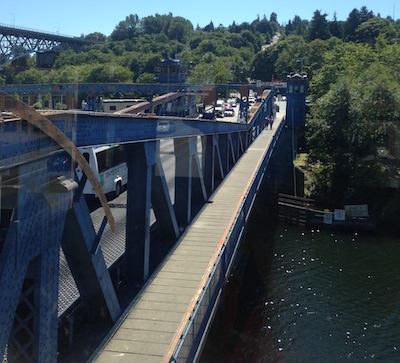LAS VEGAS—Complex containment, strict schedules and rigorous regulations earned eight painting projects top honors as SSPC 2015 opened Tuesday (Feb. 3) in Las Vegas, NV.
SSPC kicked off its annual conference and exhibition with its awards luncheon, where outgoing Executive Director Bill Shoup and President James R. King Jr. also updated members on the society's current numbers.
This year's award-winning projects were fraught with danger, difficulty and drama.
Crews scrambled around frequent bridge openings high over waterways; navigated wind-buffeted access structures; volunteered their time for historic military projects; designed innovative containment to protect wildlife; and braved a soaking-wet, cold rock-tunnel penstock 80 feet underneath a Canadian generating station.
The society also honored outstanding individuals whose careers reflect decades of service to the industry.
Structure Awards
The Structure Award winners, listed below, will also be featured in a photo essay in an upcoming issue of JPCL.
George Campbell Award
The George Campbell Award honors a difficult or complex industrial or commercial coatings project. Challenges may include extreme environmental conditions, time constraints, limited access or high traffic, complex structural components, or coordination with multiple trades or subcontractors.
The award is named for the late George Campbell, founder of Campbell Painting Company in New York.
Brooklyn Bridge: New York, NY
Owner: New York City Department of Transportation
Contractor/Applicator: Ahern Painting Contractors
Coating Supplier: Devoe High Performance Coatings
Once an avenue for P.T. Barnum's elephants to march into town, the Brooklyn Bridge—a 132-year-old hybrid stayed/suspension span—carries 120,000 vehicles and 7,000 pedestrians over the East River every day.
Traffic, existing lead coatings, outside agency coordination and sheer size necessitated a multi-tiered approach to clean and repaint the structure's 4.2 million square feet of steel beams, braces and cables.


Courtesy SSPC
For work on the Brooklyn Bridge, a complex system of hoses and duct work was designed, stretching from the SSPC Class1A containment to a custom grit recycling unit more than 1,200 feet away.
The project required coordination with the City of New York, the Boroughs of Manhattan and Brooklyn, City Hall, 1 Police Plaza, NYCDOT and the U.S. Coast Guard.
Abating the existing lead coatings created another set of challenges. The bridge's age and weight limitations, along with a requirement to keep all three lanes open for traffic, nixed any chance of placing abatement vehicles on the roadway. Therefore, a complex system of hoses and duct work was designed, stretching from the SSPC Class1A containment to a custom grit recycling unit more than 1,200 feet away.
A 20,000-panel system of under-bridge platforms was used for work on the 3,455-foot-long structure. After abrasive blast cleaning to a Near-White (SSPC-SP 10) finish, the steelwork was repainted with a four-coat system consisting of an organic zinc-rich epoxy primer, a pre-prime sealer coat, an epoxy intermediate, and an aliphatic urethane gloss finish.
The project started in January 2010 and was completed Oct. 1, 2014.
Fremont Bridge: Seattle, WA
Owner: Seattle Department of Transportation
Contractor/Applicator: Purcell Painting & Coatings LLC
Coating Supplier: The Sherwin-Williams Company
The low 30-foot vessel clearance of the Fremont Bridge, a double-leaf bascule structure spanning a heavily used navigable waterway, challenged crews to deal with frequent drawbridge interruptions and complex loading conditions.
The 97-year-old bridge, which connects Seattle's Fremont and Queen Anne neighborhoods, was last cleaned and coated in 1970. In this project, the structure was spot repaired and coated with a moisture-cured system to protect against the area's harsh wind and rain.
While working on one of the busiest bascule bridges in the world, the contractor's 37-person team had to quickly secure its work, vacuum up paint chips, and clear the bridge nearly three dozen times per day to allow it to open for marine traffic.


Seattle DOT
While working on one of the busiest bascule bridges in the world, the contractor's 37-person team had to quickly secure its work, vacuum up paint chips, and clear the bridge nearly three dozen times per day to allow the span to open for marine traffic.
A suspended platform system had to be designed to support the worker and debris load while the bridge was down, but also keep the platform stable when the bridge was raised. Engineers were also concerned that high winds would slam the platform into the underside of the bridge as it lifted vertically with the raising structure.
Therefore, a series of rigid anti-uplift and horizontal bracing members was installed to hold the deck in place, while intentionally passing the load to the stronger framing points of the bridge substructure.
The project started April 7, 2014, and was completed Dec. 30, 2014.